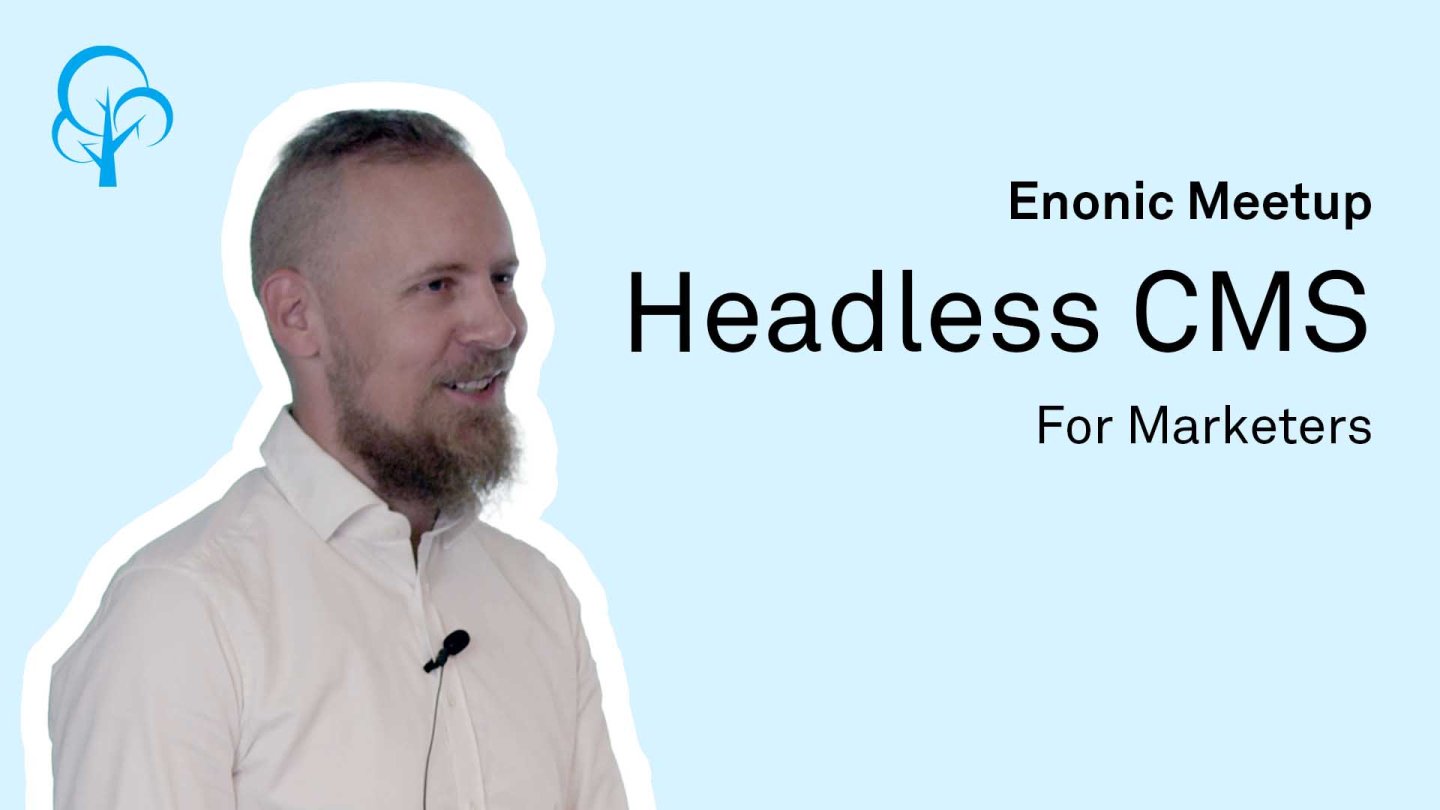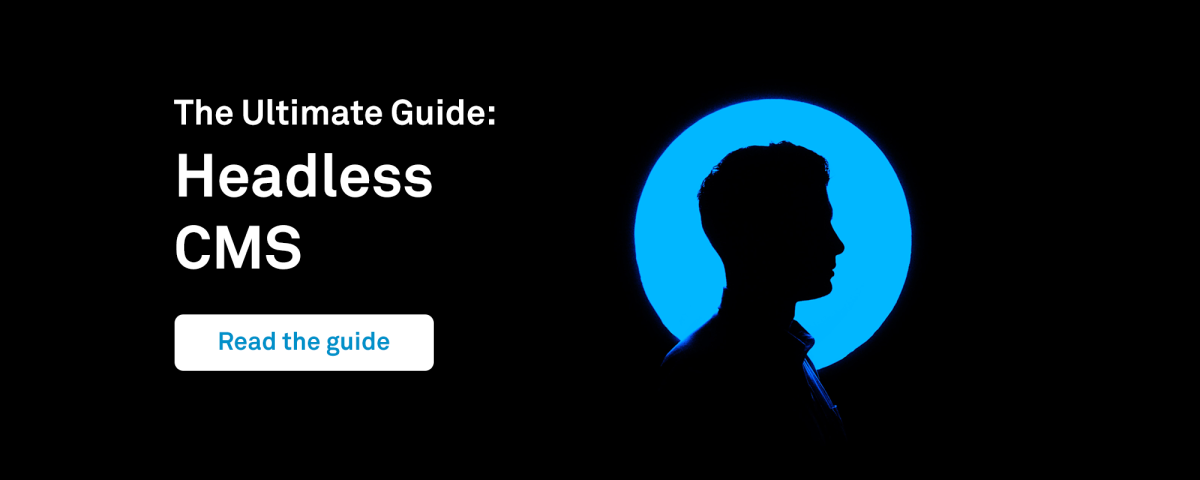
Headless CMS for marketers – the must knows
Go beyond the hype of headless CMS and discover the advantages for marketing.
Written by Vegard Ottervig on
As a web editor or a marketer, you have most likely experienced more than once that your content management system has worked against you, instead of supporting you.
While the technological developments of the past few years promise to make your digital tools faster than ever before, this isn’t necessarily true. Bigger often means more bloated, not faster. And the advanced digital experience platforms (DXPs) are certainly bigger than ever before.
But then the extremely lightweight headless CMS came along to address the increasingly fragmented world of digital experiences. What can you expect of headless CMS in regard to marketing?
No visual editing, SEO, or preview—with exceptions
Your tasks in a CMS may include producing content, building landing pages, distributing and sharing content, building SEO structure, analyzing performance, maintaining ads, and generating leads and engagement.
Now prepare to think anew. A headless CMS is nothing like the traditional CMS you have become accustomed to. For instance, in pure, first-gen headless solutions, there are no visuals, no previews, no technical SEO, no landing page setup, and not even a site hierarchy.
A headless CMS instead works with content through form-based inputs. The content in these forms, whether it is a header, a snippet, an image field, or your body text, will then be sent to different channels (desktop, mobile, wearable, IoT, voice, signage)—where the developers are responsible for the presentation.
The headless approach thus fosters closer collaboration between marketers and developers, as marketers now depend wholly on the developer to do great work on the presentation.
However, not all headless content management systems are the same. Even though many first generation headless vendors have a limited offer within SEO, visual page editing, content tree structure, and in-context preview, other headless alternatives can offer these features. So pick carefully!
Same content, different channels
As mentioned above, the present world of digital experiences and the foreseeable future will be characterized by a digital omnipresence. In the past, the digital world consisted of stationary computers. Then came laptops, but the format essentially stayed the same for a long time.
But as both the years and technology progressed, we saw an increase in the variety of digital devices and channels. The PDA, the smartphone, the tablet, the smartwatch, the wearables, the Internet of Things, as well as digital signage, voice assistants, in-store beacons, microservices, and even functions within websites.
Learn more: The history of CMS – what has happened?
Now how does a traditional, desktop-first CMS with a tight-knit connection between content and presentation relate to all these widely different channels? It must employ the headless approach, as several DXPs have demonstrated already.
Headless makes it easy to reuse content across channels and devices, as it really just is a database with form-based, structured content, presented in your chosen channels through APIs and developer-created front-ends. A headless CMS is thus a content hub, enabling your content to be more consistent across the board—if your developers have done things correctly.
A case in note here is the fact that a lot of your content is going to be exclusively on your website anyway, and much of this will not be reused—e.g. landing pages. It’s easy to be blended by the headless craze, but don’t forget that maybe a “pure” solution is overkill—maybe a headless CMS with added functionality for content editors will be more fitting for your team and organization.
Save time and effort
So a headless CMS is nothing like the traditional CMS you have become familiar with, but it does make it much easier to deliver the same content to the fragmentary world of digital experiences. The latter point, of course, opens for you saving time and effort.
Web editors and marketers no longer need to work with design as in building landing pages and content blocks. Instead, you can focus even more on the content itself—and make it the best you possibly can. No more struggling with design elements or page setup, it’s only the content that matters for you now.
Developers will be responsible to present the content in one way or another. For instance, in a native app, your content will be presented as a title and a text fragment, while on a website the same piece of content will feature all the titles and paragraphs.
This is the future: Supercharge your website with Next.js and headless CMS »
Developer experience
When talking about headless there is always a strong emphasis on the reuse of structured content. But don’t forget this: The astronomical rise of headless CMS is first and foremost developer-driven. It’s the developers who primarily want headless, and why is that?
The most important thing for your developers is not the reuse of content, but the developer experience. The developers want to get digital projects started fast, and build solutions with their favorite tools and front-end frameworks.
Maybe the “pure” first generation headless solutions appeal most to the developers, but don’t forget the content editors and marketers—i.e. you—in the process. Be sure to choose a headless CMS with added benefits, like the aforementioned visual page editing, tree structures, and previews.
More than web
We have talked about one content, multiple channels already—but this point needs to be hammered in. It should be fairly obvious by now, but headless takes into account that not every channel is a website. Not every channel has ample space for beautifully rendered images or a smart, multi-column layout.
Mobile apps, smartwatches, and wristbands are unmistakable examples of smaller screen sizes—and in the latter case, hardly a screen at all. But with headless, you can have them covered.
Headless even takes into account the other side of the scale: jumbotrons and digital signage larger than life. Videos, images, headings, or other interactive elements can be sent to a giant surface like these, while the body text—not having a natural place in such an environment—can snuggle up to smaller formats.
Being aware of new digital touchpoints in your customer journey can enable your marketing department to completely rethink their marketing efforts—to be smarter and make use of hitherto unused channels to drive new business.
Improved content
Due to you getting “one source of truth” with a headless CMS, your brand will be more uniform and consistent across wildly different channels. Better control, better quality, and more streamlined processes align closely with the marketing term “ContentOps”—content operations.
ContentOps is a content production principle placed between strategy and delivery that integrates people, process, and technology—making these three aspects work smoother together. With headless CMS as a core staple among your technology stack, you and your team can work methodically with structured content in order to choose the best part of the message for whatever channel that fits it best.
A headless CMS lets you focus on the content itself, break it up into its smallest meaningful pieces, or “atoms”, and then decide with different stakeholders what pieces go where—and why. Sounds like a recipe for improved content.
***
So, to recap very quickly: A headless CMS separates the content itself from whatever channel it will be displayed on, allowing content marketers to focus on message quality and appropriate channels, which will strengthen your brand and make it more visible.
Just make sure you choose a headless CMS that is more than a database for structured content and an API to deliver it wherever. Choose a headless CMS with tools that are sure to make not only the developers happy, but also you content marketers! Such next-gen headless CMSs are out there, they are real, they are yours.
First published 17 June 2019, updated 10 August 2022.


